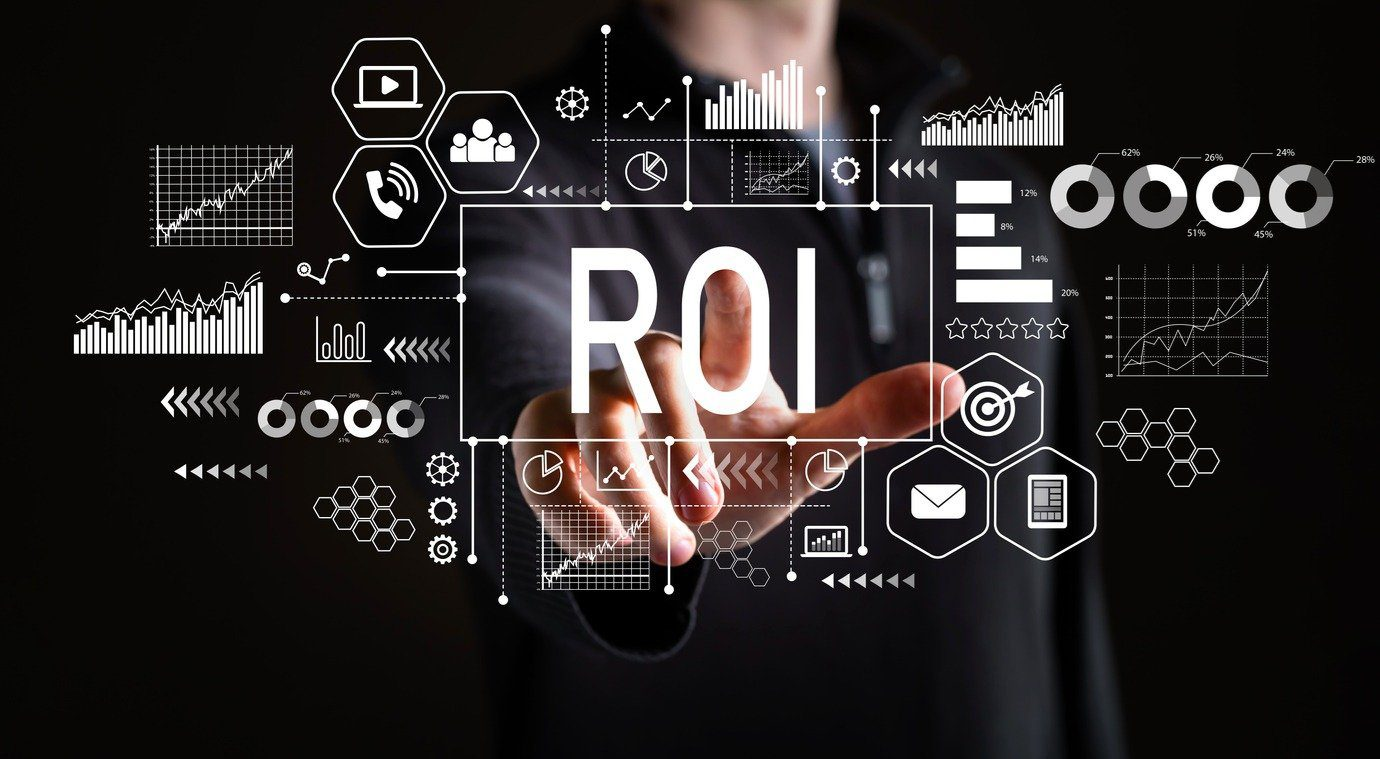In digital marketing, measuring the Return on Investment (ROI) of campaigns is essential to determine the effectiveness of strategies used. ROI provides a clear view of how much profit a campaign has generated compared to the amount invested, allowing businesses to make adjustments, optimize resources, and ensure their marketing efforts are profitable.
1. What is return on investment (ROI) in marketing?

Return on Investment (ROI) is a metric used to assess the financial return of an investment, in this case, a marketing campaign. It measures the value generated as a direct result of a campaign in relation to its total cost.
Basic ROI formula: ROI = ((Revenue – Cost) / Cost) * 100
This result is given in percentage, indicating how much you gained or lost with the campaign. A positive ROI means the campaign was profitable, while a negative ROI suggests the investment did not yield the expected return.
2. Why is return on investment important for marketing?
Measuring ROI in marketing campaigns enables businesses to evaluate the performance of different initiatives and make data-driven decisions. This is crucial to ensure that the money invested in advertising, content production, or SEO, for example, is generating the expected results.
Benefits of measuring ROI:
- Attributing real value to marketing: Marketing is often seen as an expense. Measuring ROI turns marketing into a measurable, controllable tool.
- Campaign optimization: By analyzing ROI, you can identify which campaigns are performing well and adjust those that need improvement.
- Data-based decision making: ROI provides insights to adjust marketing budgets, allocating more resources to high-return campaigns.
3. How to calculate ROI for digital marketing campaigns

Each type of marketing campaign has its own costs and ways to calculate ROI. Let’s explore how to measure ROI in various digital marketing campaigns.
3.1. ROI in paid ad campaigns (PPC)
Pay-per-click (PPC) campaigns, such as Google Ads or Facebook Ads, are among the most common forms of digital marketing. To calculate the ROI of a PPC campaign, you need to monitor the cost per click (CPC), conversion rate, and average customer value.
Steps to calculate PPC ROI:
- Track CPC (Cost per click): The amount spent on each click for your ad.
- Monitor conversions: The number of people who clicked on your ad and completed the desired action (purchase, form submission, etc.).
- Determine average conversion value: The revenue generated per conversion.
Example: If you spent $1,000 on ads and generated $3,000 in sales, ROI is calculated as: ROI = ((3000 – 1000) / 1000) * 100 = 200%
3.2. ROI in content marketing
Content marketing is a long-term strategy that can be more challenging to measure but is equally important. The focus is on attracting and converting customers through relevant content like blog posts, videos, and e-books.
Steps to calculate content marketing ROI:
- Calculate production costs: Include costs such as content creation, design, and research time.
- Track conversions from content: Use tools like Google Analytics to measure conversions generated directly from the content.
- Determine average conversion value: For example, if a blog post brought in new leads, calculate the revenue generated from these leads.
Example: If you spent $2,000 creating content and it generated $6,000 in sales, ROI is calculated as: ROI = ((6000 – 2000) / 2000) * 100 = 200%
3.3. ROI in email marketing
Email marketing continues to be one of the most effective strategies for generating positive ROI due to its low cost and high conversion. To calculate the ROI of an email campaign, you need to measure the sales or conversions generated directly from the emails sent.
Steps to calculate email marketing ROI:
- Calculate campaign costs: Include email automation tools, design, and copywriting costs.
- Track sales/conversions from emails: Use email marketing tools to track clicks and sales from the emails.
- Determine average conversion value: If the campaign brought in new customers, what was the average value of each purchase?
Example: If you spent $500 on an email marketing campaign and generated $2,000 in sales, ROI is calculated as: ROI = ((2000 – 500) / 500) * 100 = 300%
3.4. ROI in SEO (Search engine optimization)
SEO is a long-term strategy and may be harder to directly measure in terms of ROI. However, there are ways to track how search engine optimization impacts conversions and ultimately the ROI.
Steps to calculate SEO ROI:
- Determine costs: Include investments in SEO tools, content creation, and site optimization.
- Monitor organic traffic and conversions: Use Google Analytics to track traffic generated by SEO and how many of these visits convert into sales.
- Calculate conversion value: How much revenue was generated directly from visitors who came through organic search results?
Example: If you spent $3,000 on SEO over six months and it resulted in $9,000 in sales, ROI is calculated as: ROI = ((9000 – 3000) / 3000) * 100 = 200%
4. Important metrics for measuring ROI in marketing
Beyond the basic ROI calculation, there are several metrics you should monitor to better understand your marketing campaign performance.
4.1. Customer acquisition cost (CAC)
CAC is the average amount spent to acquire a new customer. Calculating CAC is crucial to understanding whether the ROI of your campaigns is healthy. A high CAC could mean you’re overspending to acquire new customers, directly affecting ROI.
Formula for calculating CAC: CAC = Total Marketing Cost / Number of New Customers
4.2. Customer lifetime value (LTV)
The Customer Lifetime Value (LTV) is the total amount a customer spends with your company over time. A high LTV means you’re retaining customers and getting long-term value from them, positively impacting ROI.
Formula for calculating LTV: LTV = Average Sale Value × Repeat Purchase Frequency × Customer Retention Duration
4.3. Conversion rate
The conversion rate is the percentage of visitors who complete the desired action, like making a purchase or filling out a form. A high conversion rate indicates that your campaigns are attracting the right audience and that your marketing strategy is effective.
Formula for calculating conversion rate: Conversion Rate = (Total Conversions / Total Visitors) × 100
5. Best practices for increasing ROI in marketing campaigns

Now that you understand how to measure ROI, it’s essential to adopt practices to optimize your campaigns and ensure that returns are maximized.
5.1. Segment your audience
One of the most effective ways to improve ROI is to precisely segment your audience. Targeting your campaigns to the right audience increases conversion chances and reduces budget waste.
Segmentation tips:
- Use demographic, behavioral, and psychographic data to segment your audience.
- Conduct A/B testing to see which messages resonate best with different segments.
5.2. Optimize the user experience (UX)
A positive user experience increases conversion chances. Ensuring your website or landing page is intuitive and mobile-optimized can reduce bounce rates and improve ROI.
Optimization tips:
- Check site loading speed and improve the design for easy navigation.
- Simplify signup and checkout forms.
5.3. Test and adjust your campaigns
Testing different variables in your campaigns is crucial for finding what works best. A/B testing allows you to test different ad versions, landing pages, and emails to maximize conversions.
Testing tips:
- Try different calls to action (CTAs) to see which generates more conversions.
- Alternate between different layouts and landing page designs to discover what converts best.
5.4. Monitor regularly
ROI isn’t static. Campaigns need regular monitoring to ensure they continue to yield positive results. Adjusting strategies as needed can help maintain optimized performance.
Monitoring tips:
- Track performance weekly or monthly.
- Use custom dashboards in Google Analytics to monitor key ROI metrics.
Measuring the Return on Investment (ROI) of your marketing campaigns is essential to ensure you’re making informed decisions and optimizing your budget use. Whether in PPC, SEO, email marketing, or content, understanding how to calculate and maximize ROI can mean the difference between profitable campaigns and wasted resources.
By following the strategies and best practices outlined here, you can ensure that your marketing campaigns bring the expected results and contribute to your company’s growth.
Frequently asked questions (FAQ) about return on investment
What is Return on Investment in marketing?
ROI in marketing measures the financial return of a campaign compared to its cost. It’s an important metric to evaluate campaign effectiveness.
How do I calculate the ROI of a digital marketing campaign?
To calculate ROI, subtract the campaign cost from the revenue generated and divide the result by the campaign cost. Multiply by 100 to get the ROI percentage.
What metrics should I track to measure ROI?
Key metrics include Customer Acquisition Cost (CAC), Customer Lifetime Value (LTV), conversion rate, and total revenue generated by the campaign.
How can I increase the Return on Investment of my marketing campaigns?
Better audience segmentation, optimizing user experience, conducting A/B testing, and regular performance monitoring are essential practices to increase ROI.
Why is ROI important in digital marketing?
ROI helps businesses understand which campaigns are effective and profitable, optimizing budget use and adjusting strategies to improve results.




